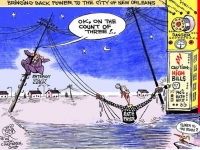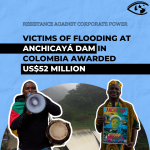Entergy Holds New Orleans for Ransom

Some New Orleanians desperately want, and fear, their utility bills.
But Tom Morgan, a DJ at New Orleans' local radio station WWOZ, hasn't seen one in months. While many residents have been hobbled by the cost of having a certified electrician reestablish electric and gas connections to their homes, some - like Morgan - have been unable to find out how much they owe and fear a gigantic bill they won't be able to pay, meaning - to add insult to injury - they face having their power cut off.
"I haven't gotten a bill since October," Morgan told CorpWatch. "I've called Entergy, but it still hasn't come. You shouldn't have to chase after people to pay your bills. A lot of people are confused and afraid."
Cutting and Running?
Entergy Corp. was the last Fortune 500 Company still based in New Orleans before Hurricane Katrina struck. Unless the federal government grants its wholly owned subsidiary, Entergy New Orleans, the $718 million it seeks to maintain and rebuild its gas and electricity infrastructure damaged in the storm, the utility might not be able to continue doing business in the city it currently supplies with gas and electric. It isn't that Entergy can't afford to rebuild; it's that it would rather keep its profits and let the federal government pick up the tab.
Entergy Corp. racked up $10 billion in revenues last year and has $29 billion in collective assets. On paper, there is no question Entergy could comfortably cover its losses and rebuild the infrastructure of its utility business in New Orleans. On May 2, Entergy announced that its first-quarter profit rose nearly 13 percent, as higher energy prices offset disrupted sales following last year's hurricanes. Entergy CEO J. Wayne Leonard received a $1.1 million bonus at the end of 2005, according to SEC records, which coincidentally works out to one dollar per Entergy customer in the Gulf Coast left without power in the weeks following the hurricane.
But the company's executives feel that if anyone should pay the cost of its getting back into business, it should be ratepayers and taxpayers, and not its own shareholders. And indeed, the government may have little choice but to give in to what critics characterize as blackmail or extortion - or leave a major American metropolis powerless.
Gordon Howald, utilities analyst with New York-based Natexis Bleichroeder, said he hasn't warned clients to sell off their Entergy stock. When Entergy first announced the possibility of bankruptcy, he says he thought the claim was a bluff.
"Entergy is a pretty successful company making a lot of money and here you have all these people who have lost their homes," he said. "Months later, they're still bickering. As time goes on, it becomes more difficult to get recovery, and ratepayers will have to pick up the rest."
Using the Federal Government as Insurance
The story of Entergy in New Orleans is a cautionary tale, critics say, of privatizing utilities as critical as gas and electricity in major population centers. Although Entergy is regulated by the New Orleans City Council, and its customer base is the local citizenry, as a publicly held company it ultimately answers first to its shareholders who want to maximize their profits. To that end Entergy has made broad use of limited liability laws to structure the company and its subsidiaries in a way that insulates shareholders from liabilities such as storms. The result is a system whereby the company's own customers and taxpayers nationwide foot the bill when something goes wrong.
Entergy has estimated its losses post-Katrina at just over $1 billion, including lost customers (many residents who fled may not come back), and miles of gas pipeline corroded by the saltwater that poured over the levees. The insurance the company carried covered $250 million in damages. The rest will likely come from inflated rates for those customers who remain in New Orleans, and from federal funds.
The Federal Energy Regulatory Commission (FERC), which has minimal oversight of Entergy, does not require companies like Entergy to carry insurance to cover losses from catastrophic events such as a hurricane, even though conventional wisdom has long considered a Katrina-sized storm and flood inevitable. The cost of the insurance it does carry may be passed on to ratepayers, according to FERC spokesman Bryan Lee.
Citing a "precedent" set by bailouts of ConEdison and the airline industry after 9/11, Entergy New Orleans is seeking a Community Development Block Grant (CDBG) to make up the difference. Without CDBG aid, Entergy New Orleans estimates that the average ratepayer's share of the losses comes to $8,943, which would be exacted in the form of a rate increase of at least 140 percent.
No Cost of Doing Business in Hurricane Alley
In the days after the storm, all public comments focused solely on restoration, as if the effort to rebuild New Orleans could be accomplished with nothing more than elbow grease and well-wishing. President George W. Bush cut an iconic pose in New Orleans' Jackson Square on September 15, 2005, with his sleeves rolled up for a prime-time television appearance as he stood in front of a statue of Andrew Jackson and vowed "one of the largest reconstruction efforts the world has ever seen."
Meltdown? Not Our Problem An Entergy subsidiary, Entergy Nuclear Northeast, operates the Indian Point nuclear power plant in Westchester County, New York. In late March, a huge crowd assembled to meet with Nuclear Regulatory Commission (NRC) and Entergy representatives, who repeatedly claimed that the numerous radioactive leaks recently detected seeping from the plant and toward the Hudson River were nothing to worry about. But the crowd was concerned, largely because they knew Entergy was positioned to protect its assets by filing for bankruptcy in the event of a nuclear disaster. Where, they wondered, was the motivation to maintain safety standards, if not the specter of lost profits? "Corporations like Entergy have the luxury of walking away from these disasters unscathed, while citizens who lose their homes and jobs will be saddled with the additional burden of having to pay for Entergy's mess," said Lisa Rainwater, Indian Point campaign director for watchdog environmental group Riverkeeper. "The new consumer bankruptcy law is yet another disturbing example of how Washington is more interested in protecting the financial interests of corporate America than the financial security of hard-working Americans. It's appalling." What has been happening in New York with Entergy Nuclear may provide clues about what's ahead for New Orleans. Activists have been sounding the alarm there for years about the potential for a private company to cut and run with its profits, leaving devastation - and a massive bill - in its wake. Indeed, the nuclear industry is no stranger to federal assistance. In July 2003, the Bush-Cheney Energy Bill was passed by Congress, and Republican Senator John McCain referred to it as the "no lobbyist left behind" bill. It was considered by many to be a bonanza for the nuclear industry, including nearly $6 billion in operating tax credits, over a billion in decommissioning subsidies for aging plants and a 20 year extension of liability caps for accidents at nuclear plants. $3 billion in research subsidies and a nearly equivalent sum for construction subsidies was included for new plants, an effort that put Entergy out in the front of the pack. Entergy Corp. made bipartisan campaign contributions totaling $1,205,983 to federal candidates during the 2004 election cycle. Gary Tayler, CEO of Entergy Nuclear, Inc. said on May 25, 2005 at a meeting of the Nuclear Energy Institute in Washington, DC, that Entergy is enjoying a "full partnership" with the Department of Energy in its quest to pave the way for the next generation of nuclear reactors. "We're putting in money and they're matching it on a dollar for dollar basis," Taylor is quoted in the July/August 2005 issue of Nuclear Plant Journal. "Clearly, they have a responsibility to ensure that this is going in the right direction." He also said that the "President is trying to say that we [the government] will provide some financial certainty if things fall apart..." On August 7, 2002, Synapse Energy Economics published a report, "Financial Insecurity: The Increasing Use of Limited Liability Companies and Multi-Tiered Holding Companies to Own Nuclear Power Plants," which was commissioned in part by Riverkeeper. Former Commissioner of the NRC, Peter Bradford, wrote in his the foreword that the Synapse report "dissects a troublesome set of developments on the cusp between economic and safety regulation, namely, the arrangement of nuclear plant ownership into the limited liability subsidiaries of a few large companies. Because this arrangement has occurred during a period of lax and dispirited regulation, some important issues have not been pursued effectively." Years of "reckless undermining," he said, have now been "exposed in a series of financial collapses," among them a "ruinous mix of money, pressure...complexity and ideology." "Regulating in this way is like driving drunk," Bradford went on. "Taxpayers, utility customers and power plant neighbors who thought themselves protected by firm requirements may one day wear the stunned expressions of Enron retirement plan holders or WorldCom investors." According to Synapse, limited liability structure is an "effective mechanism" for transferring profits up the chain while creating a shield for the parent in case an unanticipated cost occurs at one of the plants.
|
"Throughout the area hit by the hurricane," Bush pledged, "we will do what it takes, we will stay as long as it takes, to help citizens rebuild their communities and their lives." Two weeks later, on October 4 in the Rose Garden at the White House, Bush had a new philosophy: cut non-security spending to fund the recovery effort - when necessary.
"As the federal government meets its responsibilities, the people of the Gulf Coast must also recognize its limitations," Bush said. "The engine that drives growth and job creation in America is the private sector, and the private sector will be the engine that drives the recovery of the Gulf Coast."
Entergy New Orleans heard the siren call of a bailout.
In November of 2005, according to a Reuters report, Entergy unveiled a $3 billion plan that it said would "ensure liquidity" while it "awaits recovery." During a conference call with analysts at that time, Leonard said the company intended to be "relentless in recovery of storm costs."
"New Orleans is Entergy's home and we are absolutely dedicated to the city's reconstruction and resurrection," said Leonard immediately after the storm. "We are hopeful that we will be able to return home soon. Our ability to do that depends, of course, on a number of factors over which we do not have complete control."
"We are heartsick at the losses our communities and employees have suffered," said Curt L. Hebert, executive vice president, external affairs at Entergy Corp. in a public statement. "Even as we launch the largest power restoration in our country's history, we are equally concerned about reaching out to help our co-workers, families and neighbors restore their lives. Together we can and will rebuild and put this storm behind us."
Hebert is a product of the corporate-political revolving door. He was appointed chairman of FERC in 2001 by Bush, but stepped down months later, in September 2001, to take his position at Entergy Corp. He was in charge of lobbying the federal government for aid money after Katrina. That put him at odds with the chairman of the Gulf Coast Recovery and Rebuilding Council, Allan B. Hubbard, whose job it was to explain to Entergy that the feds would not be underwriting the company's New Orleans reconstruction effort.
In a letter dated November 16, 2005, Hebert noted he was "gravely disappointed," that the people of New Orleans would "suffer significantly" as a result of the Bush Administration's "fundamentally flawed" perspective. This stance, he charged, "repudiates the promise" made by Bush in Jackson Square.
"I also want to state clearly," Hebert wrote, "that [Entergy's shareholders and bondholders] have invested in a regulatory agency with the knowledge that the government regulates and protects their opportunity to earn a return."
With those words, Hebert inadvertently laid out the billion-dollar question: where do the boundaries of corporate welfare start and end?
In a response dated November 18, Hubbard pointed out Entergy's healthy bottom line while musing about the "inappropriate" nature of asking the federal government a handout while clasping a fistful of dollars.
"You told us that the ... board of the parent has a fiduciary duty not to take funds from other subsidiaries and use them to subsidize New Orleans," Hubbard wrote. "We respect the right of your board to decide how to allocate financial resources, such as last year's $909 million in earnings among various parts of Entergy Corp. We in turn believe it is inappropriate to transfer taxpayer resources to those investors after the fact for a risk they chose to take."
Prudent investors, he added, consider the risks inherent in any investment they make, including the risks of a natural disaster.
Ten days later, in a seven-page letter that smacked of one-upmanship, Hebert threatened that without "immediate federal assistance, it is unlikely that Entergy New Orleans can continue as a viable commercial entity." The threat was on the table: pay up or we pull up stakes.
Hebert also took exception to Hubbard's analysis, arguing that investment risk in a private company might be one thing, but risk in a publicly regulated utility quite another. He insisted that such public-private companies are by nature "entitled the opportunity to recover ... storm restoration costs."
Hebert says the obvious parallel and precedent was September 11. In the aftermath of that disaster, Congress passed the 2002 Supplemental Appropriation Act for Further Recovery From and Response to Terrorist Attacks on the United States. The $783 million in resulting CDBG funding included restoration of utility infrastructure for ConEdison, which, like Entergy New Orleans, is a publicly regulated utility and a subsidiary of a vast holding company. The airline industry, also, was offered a $5 billion bailout after 9/11 and a guarantee of up to $10 billion.
What Can Be Predicted Can Be Insured Against
But is a terrorist attack really a precedent for a natural disaster?
Not at all, said Howard Kunreuther, Cecilia Yen Koo Professor of Decision Sciences and Public Policy and Co-Director of the Wharton Risk Management and Decision Processes Center at the University of Pennsylvania's Wharton School. Kunreuther has studied and written about the issue of insurance extensively, including an August 2005 report on "Terrorism Risk Financing in the United States," which outlines the many ways in which terrorism is a unique threat, and a January 2006 University of Pennsylvania Press publication, Has the Time Come for Comprehensive Natural Disaster Insurance? This work includes a chapter, "On Risk and Disaster: Lessons Learned from Hurricane Katrina."
"9/11 is not a fair precedent for a natural disaster at all," Kunreuther told CorpWatch. "They're both very different in how they've been treated by the insurance industry. With a terrorist attack, you have less control. With a natural disaster, you can protect yourself to some degree."
Those who claim that Katrina was a completely unpredictable event may not have seen the many articles in publications ranging from National Geographic to a five-part series published pre-Katrina in the New Orleans Times-Picayune detailing the potential ramifications of just such a storm. And then there was Eric Berger's article in the Houston Chronicle on December 1, 2001, months after the Bush Administration's announcement of intent to downsize FEMA, in which it was reported that FEMA had declared the top three likeliest devastating emergencies in the United States to be a terrorist attack in New York City, a hurricane hitting New Orleans and a massive earthquake on the San Andreas fault.
Deregulation Comes Back to Roost
According to a May 2004 report from the United States General Accounting Office (GAO), limited liability companies such as Entergy Corp resulted from the deregulation of the electricity industry in the 1990s. "Like a partnership," the report said, "the profits are passed through and taxable to the owners ... like a corporation, it is a separate and distinct legal entity and the owners are insulated from personal liability for its debts and liabilities."
Such structures are made of loopholes the way some castles are made of sand-both, it turns out, can crumble under the sheer force of water.
"Entergy is a great example of how a company can shift liabilities to maximize profits while limiting liability," said Phillip Musegaas, senior policy analyst for the environmental watchdog group Riverkeeper, which is fighting to shut down the Entergy-owned and operated Indian Point nuclear power plants in Buchanan, New York. "Corporate restructuring is very sophisticated. They know their way out of regulation. They are way ahead of us."
All Profit, No Risk
It isn't "fair," said Entergy spokesman Stewart, to pass the cost of reconstructing Entergy New Orleans, the smallest subsidiary under the Entergy Corp umbrella, along to shareholders when the future fate of the company is still uncertain. Stewart explained that each subsidiary is a "separate business," and that each company is "protected from the burden" of picking up unexpected costs from the others.
"It would be irresponsible," Stewart told us. "It would not be prudent to invest shareholder money into the utility if there's no chance of recouping the money."
The corporation also has a "moral responsibility," he added, not to "risk the retirement funds of employees when we don't know if customers are returning."
Utility investors rely on a "business model," he said, that allows for the utility to pass the costs of reconstruction and damage from natural events along to ratepayers. With the exception of totally decimated areas of New Orleans, power has been returned to "anyone who can take it." He likened the devastation in the region to that suffered by orange juice producers when frost nips the growing season short.
"The price of juice goes up," he said, "and that's the models investors have invested in here."
Elizabeth Raley, spokesperson for Entergy New Orleans, acknowledged that customers are "very upset."
"We're faced with many customers who have extremely high bills because the natural gas wells in the Gulf of Mexico were damaged," she said. "The market rate for gas is passed on to our customers. ... We're working with customers to help them find a way to pay their bills. It's challenging to serve our customers, but that's what we're doing."
New Orleanians are wary and suspicious of what Entergy may do next. "Our customers have been through life-altering situations," Raley said. "I wouldn't be surprised if some of them feel hostility simply because they are having a rough time."
It turns out that the hostility dates from long before the storm, evidenced by a series of local and federal lawsuits. In an SEC 10-K filing, Entergy Corp describes its relationship with the state of Louisiana as "particularly litigious." 480 class action lawsuits including 10,000 claims have been filed against Entergy's various Gulf Coast subsidiaries, including Entergy New Orleans, for damages allegedly caused by disposal of hazardous waste and "asbestos-related disease" by contractor employees who worked between the years 1950 and 1980 and claim to have been exposed to hazardous materials during that time. In March 2004, endangered brown pelicans were found dead near Entergy New Orleans' Michoud power plant intake structure and return trough. And then there were the ratepayer lawsuits brought on by the City Council, during which it was alleged in testimony filed over a period of years that customers had been overcharged by upwards of $100 million. When the matter was settled in April 2003, ratepayers were reimbursed $11.3 million when it was found that Entergy had been incorrectly calculating the cost of fuel and passing the error along to customers.
This had all been sorted out since, according to Clinton A. Vince, managing partner of Sullivan & Worcester's Washington DC office, which represents the New Orleans City Council, the regulatory agency responsible for oversight of Entergy New Orleans. Vince supports the idea of a CDBG bailout.
"I won't second-guess them on their system. Nobody ever could have anticipated a flood of this magnitude," he said when asked why pipes that were susceptible to corrosion salt water were buried underground in a city that lies below sea-level. "This was not a reasonably foreseeable event."
"Entergy needs a reorganization plan," Vince said. "The content of that plan will change drastically based on CDBG funds. There would be dire consequences if Entergy walked away. We need the utility to stay there and rebuild the system. It's a unique situation-the worst disaster for a utility in the history of the country. People have lost everything, and it would be unrealistic and unfair to pass those costs along [to ratepayers]. People would have no incentive to return."
On March 30, 2006, Donald Powell, the Bush administration's Gulf Coast recovery coordinator, said the revival of the Crescent City could take up to a quarter of a century and also hinges on factors that are "out of our control." The amount of total funds that will be allotted by the state and federal governments, Powell said, is still up in the air.
Will Entergy choose - or be forced - to cut and run from New Orleans?
"Our plan is to stick it out," Entergy New Orleans' spokeswoman Raley told Corpwatch. "We're very hopeful that our funds will come through, and we'll be able to continue to operate."
- 107 Energy



